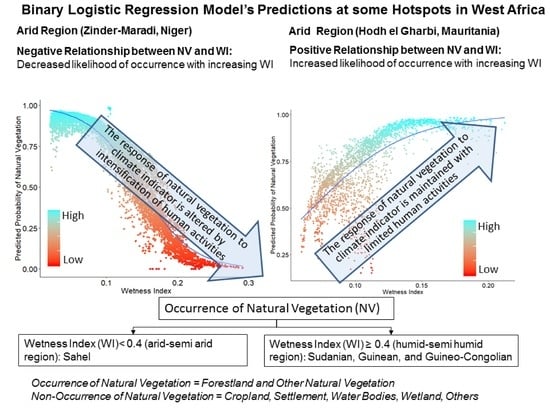Modeling the Underlying Drivers of Natural Vegetation Occurrence in West Africa with Binary Logistic Regression Method
Abstract
Highlights
- Underlying drivers of natural vegetation were identified by Binary Logistic Regression.
- Multiple underlying drivers were significant at p < 0.05 with varying impacts.
- Human activities indicators were the dominant underlying drivers.
- The response of natural vegetation to climate was altered by intensification of human activities.
1. Introduction
2. Study Area and Datasets
2.1. Study Area: Selected Hotspots in West Africa
2.1.1. Site 1: Diourbel-Louga (Senegal)
2.1.2. Site 2: Hodh el Gharbi (Mauritania)
2.1.3. Site 3: Zinder-Maradi (Niger)
2.1.4. Site 4: Centre and Centre Sud (Burkina Faso)
2.1.5. Site 5: Ghana (Ashanti Region)
2.1.6. Site 6: Nigeria (Niger State)
2.2. Datasets
3. Methodology
3.1. Binary Logistic Regression (BLR) Model
3.2. Data Preparation
3.3. Multi-Collinearity Analysis
3.4. Model Development
3.5. Model Validation
4. Results
4.1. Multi-Collinearity
4.2. Significant Underlying Drivers of Natural Vegetation Identified from the Binary Logistic Regresion (BLR) Model
4.3. Model Validation
4.4. The Relationship between the Significant Underlying Drivers and Natural Vegetation
5. Discussion
5.1. Multi-Collinearity
5.2. Significant Underlying Drivers Identified by the Binary Logistic Regression (BLR) Model
5.3. Model Validation
5.4. The Relationship between the Significant Underlying Drivers and Occurrence of Natural Vegetation
5.4.1. Human Activities (HANPP) and Demography (Population Density)
5.4.2. Livestock Density
5.4.3. Accessibility (Travel Time)
5.4.4. Climate (Wetness Index)
5.4.5. Soil Type, Elevation, and Slope
6. Conclusions
Author Contributions
Funding
Institutional Review Board Statement
Informed Consent Statement
Data Availability Statement
Acknowledgments
Conflicts of Interest
References
- Turner, A.B.L.; Meyer, W.B.; Skole, D.L. Global Land-Use/Land-Change: Towards an Integrated Study. Integr. Earth Syst. Sci. 2009, 23, 91–95. [Google Scholar]
- Foley, J.A.; Defries, R.; Asner, G.P.; Barford, C.; Bonan, G.; Carpenter, S.R.; Chapin, F.S.; Coe, M.T.; Daily, G.C.; Gibbs, H.K.; et al. Global Consequences of Land Use. Science 2010, 309, 570–574. [Google Scholar] [CrossRef]
- Lambin, E.F.; Geist, H.J.; Lepers, E. Dynamics of land-use and land-cover change in tropical regions. Annu. Rev. Environ. Resour. 2003, 28, 206–216. [Google Scholar] [CrossRef]
- Steffen, W.; Sanderson, A.; Tyson, P.; Jäger, J.; Matson, P.; Moore, B., III; Oldfield, F.; Oldfield, F.; Richardson, K.; Oldfield, F.; et al. Global Change and the Earth System: A Plane under Pressure; Springer: Berlin/Heidelberg, Germany, 2005; ISBN 9783540265948. [Google Scholar]
- Ehlers, E.; Krafft, T. (Eds.) Earth System Science in the Anthropocene; Springer: Berlin/Heidelberg, Germany, 2016; Volume 53, ISBN 9788578110796. [Google Scholar]
- UNEP. Sahel Atlas of Changing Landscapes:Tracing Trends and Variations in Vegetation Cover and Soil Condition; UNEP: Nairobi, Kenya, 2012; ISBN 9789280733006. [Google Scholar]
- Nicholson, S.E.; Tucker, C.J.; Ba, M.B. Desertification, drought, and surface vegetation: An example from the West African sahel. Bull. Am. Meteorol. Soc. 1998, 79, 815–830. [Google Scholar] [CrossRef]
- Hulme, M. Climatic perspectives on Sahelian desiccation: 1973 1998. Glob. Environ. Chang. 2001, 11, 19–29. [Google Scholar] [CrossRef]
- Tucker, C.J.; Dregne, H.E.; Newcomb, W.W. Expansion and contraction of the Sahara Desert from 1980 to 1990. Science 1991, 253, 299–301. [Google Scholar] [CrossRef]
- Nicholson, S.E. Land surface-atmosphere interaction: Physical processes and surface changes and their impact. Prog. Phys. Geogr. 1988, 12, 36–65. [Google Scholar] [CrossRef]
- Asenso Barnieh, B.; Jia, L.; Menenti, M.; Zhou, J.; Zeng, Y. Mapping Land Use Land Cover Transitions at Different Spatiotemporal Scales in West Africa. Sustainability 2020, 12, 8565. [Google Scholar] [CrossRef]
- Brink, A.B.; Eva, H.D. Monitoring 25 years of land cover change dynamics in Africa: A sample based remote sensing approach. Appl. Geogr. 2009, 29, 501–512. [Google Scholar] [CrossRef]
- Vittek, M.; Brink, A.; Donnay, F.; Simonetti, D.; Desclé, B. Land Cover Change Monitoring Using Landsat MSS/TM Satellite Image Data over West Africa between 1975 and 1990. Remote Sens. 2014, 6, 658–676. [Google Scholar] [CrossRef]
- Lambin, E.F.; Turner, B.L.; Geist, H.J.; Agbola, S.B.; Angelsen, A.; Folke, C.; Bruce, J.W.; Coomes, O.T.; Dirzo, R.; George, P.S.; et al. The causes of land-use and land-cover change: Moving beyond the myths. Glob. Environ. Chang. 2001, 11, 261–269. [Google Scholar] [CrossRef]
- Geist, H.J.; Lambin, E.F. Proximate Causes and Underlying Driving Forces of Tropical Deforestation. Bioscience 2002, 52, 143–150. [Google Scholar] [CrossRef]
- Chomitz, K.M.; Gray, D.A. Roads, Land Use, and Deforestation: A Spatial Model Applied to Belize Roads, Land Use, and Deforestation. World Bank Econ. Rev. 1996, 10, 487–512. [Google Scholar] [CrossRef]
- Hickler, T.; Eklundh, L.; Seaquist, J.W.; Smith, B.; Ardo, J.; Olsson, L.; Sykes, M.T.; Sjo, M. Precipitation controls Sahel greening trend. Geophys. Res. Lett. 2005, 32, 2–5. [Google Scholar] [CrossRef]
- Seaquist, J.W.; Hickler, T.; Eklundh, L.; Ardö, J.; Heumann, B.W. Disentangling the effects of climate and people on Sahel vegetation dynamics. Biogeosciences 2009, 6, 469–477. [Google Scholar] [CrossRef]
- Anyamba, A.; Tucker, C.J. Analysis of Sahelian vegetation dynamics using NOAA-AVHRR NDVI data from 1981 – 2003. J. Arid Environ. 2005, 63, 596–614. [Google Scholar] [CrossRef]
- Huber, S.; Fensholt, R.; Rasmussen, K. Water availability as the driver of vegetation dynamics in the African Sahel from 1982 to 2007. Glob. Planet. Change 2011, 76, 186–195. [Google Scholar] [CrossRef]
- Brandt, M.; Rasmussen, K.; Peñuelas, J.; Tian, F.; Schurgers, G.; Verger, A.; Mertz, O.; Palmer, J.R.B.; Fensholt, R. Human population growth offsets climate-driven increase in woody vegetation in sub-Saharan Africa2. Nat. Ecol. Evol. 2017, 1, 4–9. [Google Scholar] [CrossRef] [PubMed]
- Mazzucato, V.; Niemeijer, D.; Mazzucato, V.; Niemeijer, D. Population Growth and the Environment in Africa: Local Informal Institutions, the Missing Link. Econ. Geogr. 2009, 78, 171–193. [Google Scholar] [CrossRef]
- Herrmann, S.M.; Brandt, M.; Rasmussen, K.; Fensholt, R. Accelerating land cover change in West Africa over four decades as population pressure increased. Commun. Earth Environ. 2020, 1. [Google Scholar] [CrossRef]
- Linard, C.; Gilbert, M.; Snow, R.W.; Noor, A.M.; Tatem, A.J. Population Distribution, Settlement Patterns and Accessibility across Africa in 2010. PLoS One 2012, 7. [Google Scholar] [CrossRef] [PubMed]
- Boschetti, M.; Nutini, F.; Brivio, P.A.; Bartholomé, E.; Stroppiana, D.; Hoscilo, A. Identification of environmental anomaly hot spots in West Africa from time series of NDVI and rainfall. ISPRS J. Photogramm. Remote Sens. 2013, 78, 26–40. [Google Scholar] [CrossRef]
- Brandt, M.; Hiernaux, P.; Rasmussen, K.; Mbow, C.; Kergoat, L.; Tagesson, T.; Ibrahim, Y.Z.; Wélé, A.; Tucker, C.J.; Fensholt, R. Assessing woody vegetation trends in Sahelian drylands using MODIS based seasonal metrics. Remote Sens. Environ. 2016, 183, 215–225. [Google Scholar] [CrossRef]
- Rishmawi, K.; Prince, S.D. Environmental and anthropogenic degradation of vegetation in the Sahel from 1982 to 2006. Remote Sens. 2016, 8, 948. [Google Scholar] [CrossRef]
- Leroux, L.; Bégué, A.; Lo, D.; Jolivot, A.; Kayitakire, F. Driving forces of recent vegetation changes in the Sahel: Lessons learned from regional and local level analyses. Remote Sens. Environ. 2017, 191, 38–54. [Google Scholar] [CrossRef]
- Kleemann, J.; Baysal, G.; Bulley, H.N.N.; Fürst, C. Assessing driving forces of land use and land cover change by a mixed-method approach in north-eastern Ghana, West Africa. J. Environ. Manage. 2017, 196, 411–442. [Google Scholar] [CrossRef]
- Verburg, P.H.; van Eck, J.R.R.; de Nijs, T.C.M.; Dijst, M.; Schot, P. Determinants of land-use change patterns in the Netherlands. Environ. Plan. B Plan. Des. 2004, 31, 125–150. [Google Scholar] [CrossRef]
- Fasika, A.; Motuma, T.; Gizaw, T. Land Use Land Cover Change Trend and Its Drivers in Somodo Watershed South Western, Ethiopia. African J. Agric. Res. 2019, 14, 102–117. [Google Scholar] [CrossRef]
- Betru, T.; Tolera, M.; Sahle, K.; Kassa, H. Trends and drivers of land use / land cover change in Western Ethiopia. Appl. Geogr. 2019, 104, 83–93. [Google Scholar] [CrossRef]
- Pricope, N.G.; Husak, G.; Lopez-carr, D. The climate-population nexus in the East African Horn: Emerging degradation trends in rangeland and pastoral livelihood zones Narcisa. Glob. Environ. Chang. 2013, 23, 1525–1541. [Google Scholar] [CrossRef]
- Braimoh, A.K.; Vlek, P.L.G. Scale-Dependent Relationships between Land-Use Change and Its Determinants in the Volta Basin of Ghana. Earth Interact. 2004, 8, 1–23. [Google Scholar] [CrossRef]
- Kindu, M.; Schneider, T.; Döllerer, M.; Teketay, D.; Knoke, T. Scenario modelling of land use / land cover changes in Munessa-Shashemene landscape of the Ethiopian highlands. Sci. Total Environ. 2018, 623, 534–546. [Google Scholar] [CrossRef]
- Nelder, J.; Wedderburn, R.W.M. Generalized linear models. J. R. Stat. Soc. 1972, A135, 370–384. [Google Scholar] [CrossRef]
- McCullough, P.; Nelder, J.A. Generalized Linear Models, 2nd ed.; Chapman & Hall: New York, NY, USA, 1989. [Google Scholar]
- Ayalew, L.; Yamagishi, H. The application of GIS-based logistic regression for landslide susceptibility mapping in the Kakuda-Yahiko Mountains, Central Japan. Geomorphology 2005, 65, 15–31. [Google Scholar] [CrossRef]
- Razanamahandry, L.C.; Andrianisa, H.A.; Karoui, H.; Podgorski, J.; Yacouba, H. Prediction model for cyanide soil pollution in artisanal gold mining area by using logistic regression. Catena 2018, 162, 40–50. [Google Scholar] [CrossRef]
- Shu, B.; Zhang, H.; Li, Y.; Qu, Y.; Chen, L. Spatiotemporal variation analysis of driving forces of urban land spatial expansion using logistic regression: A case study of port towns in Taicang City, China. Habitat Int. 2014, 43, 181–190. [Google Scholar] [CrossRef]
- Hemasinghe, H.; Rangali, R.S.S.; Deshapriya, N.L.; Samarakoon, L. Landslide susceptibility mapping using logistic regression model (a case study in Badulla District, Sri Lanka). Proc. Eng. 2018, 212, 1046–1053. [Google Scholar] [CrossRef]
- Fox, J.; Weisberg, S. An R Companion to Applied Regression, 3rd ed.; SAGE Publications: Los Angeles, CA, USA, 2018; ISBN 9781544336459. [Google Scholar]
- Yalcin, A.; Reis, S.; Aydinoglu, A.C.; Yomralioglu, T. A GIS-based comparative study of frequency ratio, analytical hierarchy process, bivariate statistics and logistics regression methods for landslide susceptibility mapping in Trabzon, NE Turkey. Catena 2011, 85, 274–287. [Google Scholar] [CrossRef]
- Harrrell, F.E., Jr. Regression Modeling Strategies, 2nd ed.; Springer: Nashville, TN, USA, 2015; Volume 45, ISBN 9783319194240. [Google Scholar]
- Mazzocco, T.; Hussain, A. Novel logistic regression models to aid the diagnosis of dementia. Expert Syst. Appl. 2012, 39, 3356–3361. [Google Scholar] [CrossRef]
- Cao, Y.; Zhang, X.; Fu, Y.; Lu, Z.; Shen, X. Urban spatial growth modeling using logistic regression and cellular automata: A case study of Hangzhou. Ecol. Indic. 2020, 113, 106200. [Google Scholar] [CrossRef]
- Menard, S. Logistic Regression: From Introductory to Advanced Concepts and Applications; SAGE Publications Inc.: Thousand Oaks, CA, USA, 2009; ISBN 9781412974837. [Google Scholar]
- Lopez, S. Modeling Agricultural Change through Logistic Regression and Cellular Automata: A Case Study on Shifting Cultivation. J. Geogr. Inf. Syst. 2014, 06, 220–235. [Google Scholar] [CrossRef][Green Version]
- Das, I.; Sahoo, S.; van Westen, C.; Stein, A.; Hack, R. Landslide susceptibility assessment using logistic regression and its comparison with a rock mass classification system along a road section in the northern Himalayas (India). Geomorphology 2010, 114, 627–637. [Google Scholar] [CrossRef]
- Tsangaratos, P.; Ilia, I. Comparison of a logistic regression and Naïve Bayes classifier in landslide susceptibility assessments: The influence of models complexity and training dataset size. Catena 2016, 145, 164–179. [Google Scholar] [CrossRef]
- Hosmer, D.W.; Lemeshow, S. Applied Logistic Regression; John Wiley & Sons Inc.: New York, NY, USA, 2000. [Google Scholar]
- Fitzmaurice, G.M.; Laird, N.M. Binary Response Models and Logistic Regression, 2nd ed.; Elsevier: Boston, MA, USA, 2015; Volume 2, ISBN 9780080970875. [Google Scholar]
- Agresti, A. An Introduction to Categorical Data Analysis; Wiley: New York, NY, USA, 1996. [Google Scholar]
- Teferi, E.; Bewket, W.; Uhlenbrook, S.; Wenninger, J. Understanding recent land use and land cover dynamics in the source region of the Upper Blue Nile, Ethiopia: Spatially explicit statistical modeling of systematic transitions. Agric. Ecosyst. Environ. 2013, 165, 98–117. [Google Scholar] [CrossRef]
- FAO. World Reference Base for Soil Resources 2014. International Soil Classification System for Naming Soils and Creating Legends for Soil Maps; FAO: Rome, Italy, 2015; ISBN 9789251083697. [Google Scholar]
- Trabucco, A.; Zomer, R.J. Global Aridity Index (Global-Aridity) and Global Potential Evapo-Transpiration (Global-PET) Geospatial Database. Available online: http://www.csi.cgiar.org (accessed on 22 June 2018).
- Imhoff, M.L.; Bounoua, L.; Ricketts, T.; Loucks, C.; Harriss, R.; Lawrence, W. Global patterns in human consumption of net primary production. Nature 2004, 429, 870–873. [Google Scholar] [CrossRef] [PubMed]
- Robinson, T.P.; William Wint, G.R.; Conchedda, G.; Van Boeckel, T.P.; Ercoli, V.; Palamara, E.; Cinardi, G.; D’Aietti, L.; Hay, S.I.; Gilbert, M. Mapping the global distribution of livestock. PLoS ONE 2014, 9. [Google Scholar] [CrossRef] [PubMed]
- Nelson, A.; Weiss, D.J.; van Etten, J.; Cattaneo, A.; McMenomy, T.S.; Koo, J. A suite of global accessibility indicators. Sci. Data 2019, 266. [Google Scholar] [CrossRef]
- Zwarts, L.; Bijlsma, R.; van der Kamp, J.; Wymenga, E. Living on the Edge: Wetlands and Birds in a Changing Sahel; KNNV Uitgeverij: Zeist, The Netherlands, 2009; ISBN 9789050112802. [Google Scholar]
- Comité Inter-états de Lutte contre la Sécheresse dans le Sahel (CILSS). Landscapes of West Africa–A Window on a Changing World; United States Geological Survey: Garretson, SD, USA, 2016.
- Herrmann, S.M.; Tappan, G.G. Vegetation impoverishment despite greening: A case study from central Senegal. J. Arid Environ. 2013, 90, 55–66. [Google Scholar] [CrossRef]
- Brandt, M.; Hiernaux, P.; Tagesson, T.; Verger, A.; Rasmussen, K.; Aziz, A.; Mbow, C.; Mougin, E.; Fensholt, R. Woody plant cover estimation in drylands from Earth Observation based seasonal metrics. Remote Sens. Environ. 2016, 172, 28–38. [Google Scholar] [CrossRef]
- Sendzimir, J.; Reij, C.P.; Magnuszewsk, P. Rebuilding Resilience in the Sahel: Regreening in the Maradi and Zinder Regions of Niger. Ecol. Soc. 2011, 16. [Google Scholar] [CrossRef]
- Reij, C.; Tappan, G.; Smale, M. Agroenvironmental Transformation in the Sahel:Another Kind of “Green Revolution”; 00914; IFPRI: Washington, DC, USA, 2009. [Google Scholar]
- Acheampong, E.O.; Macgregor, C.J.; Sloan, S.; Sayer, J. Deforestation is driven by agricultural expansion in Ghana’s forest reserves. Sci. African 2019, 5. [Google Scholar] [CrossRef]
- Center for International Earth Science Information Network—CIESIN—Columbia University. Gridded Population of the World, Version 4 (GPWv4): Population Density Adjusted to Match 2015 Revision UN WPP Country Totals. Palisades, NY: NASA Socioeconomic Data and Applications Center (SEDAC). Available online: https://sedac.ciesin.columbia.edu/data/set/gpw-v4-population-density-adjusted-to-2015-unwpp-country-totals-rev11 (accessed on 14 February 2018).
- Pontius, R.G., Jr.; Schneider, L.C. Land-use change model validation by a ROC method for the Ipswich watershed, Massachusetts, USA. Agric. Ecosyst. Environ. 2001, 85, 239–248. [Google Scholar] [CrossRef]
- Skiena, S.S. The Data Science Design Manual; Gries, D., Hazzan, O., Schneider, F.B., Eds.; Springer: New York, NY, USA, 2017; ISBN 978-3-319-55443-3. [Google Scholar]
- Cox., D.R. The regression analysis of binary sequences (with discussion). J. Roy. Stat. Soc. B 1958, 20, 215–242. [Google Scholar]
- Wax, Y. Collinearity diagnosis for a relative risk regression analysis: An application to assessment of diet-cancer relationship in epidemiological studies. Stat Med 1992, 11, 1273–1287. [Google Scholar] [CrossRef]
- Quinn, G.P.; Keough, M.J. Experimental Design and Data Analysis for Biologists; Cambridge University Press: New York, NY, USA, 2002; Volume 277, ISBN 0-521-00976-6/0-521-81128-7. [Google Scholar]
- Steyerberg, E.W.; Bossuyt, P.M.M.; Lee., K.L. Clinical trials in acute myocardial infarction: Should we adjust for baseline characteristics? Am Hear. J 2000, 139, 745–751. [Google Scholar] [CrossRef]
- Breiman, L. The little bootstrap and other methods for dimensionality selection in regression: X-fixed prediction error. J Am Stat Assoc 1992, 87, 738–754. [Google Scholar] [CrossRef]
- Atkinson, C. A note on the generalized information criterion for choice of a model. Biometrika 1980, 67, 413–418. [Google Scholar] [CrossRef]
- Steyerberg, E.W.; Vickers, A.J.; Cook, N.R.; Gerds, T.; Gonen, M.; Obuchowski, N.; Pencina, M.J.; Kattan., M.W. Assessing the performance of prediction models: A framework for traditional and novel measures. Epidemiology 2010, 21, 128–138. [Google Scholar] [CrossRef]
- Steyerberg, E.W.; Harrell, F.E.; Borsboom, G.J.J.M.; Eijkemans, M.J.C.; Vergouwe, Y.; Habbema, J.D.F. Internal validation of predictive models: Efficiency of some procedures for logistic regression analysis. J. Clin. Epidemiol. 2001, 54, 774–781. [Google Scholar] [CrossRef]
- Steyerberg, E.W.; Eijkemans, M.J.C.; Harrell, F.E.; Habbema, J.D.F. Prognostic modeling with logistic regression analysis: In search of a sensible strategy in small data set. Med. Decis. Mak. 2001, 21, 45–56. [Google Scholar] [CrossRef]
- Zweig, M.H.; Campbell, G. Receiver-operating characteristic (ROC) plots: A fundamental evaluation tool in clinical medicine. Clin. Chem. 1993, 39, 561–577. [Google Scholar] [CrossRef]
- Fawcett, T. An introduction to ROC analysis. Pattern Recognit. Lett. 2006, 27, 861–874. [Google Scholar] [CrossRef]
- Steyerberg, E.W.; Eijkemans, M.J.C.; Harrell, F.E.; Habbema, J.D.F. Prognostic modelling with logistic regression analysis: A comparison of selection and estimation methods in small data sets. Stat. Med. 2000, 19, 1059–1079. [Google Scholar] [CrossRef]
- Copas, J.B.; Long, T. Estimating the residual variance in orthogonal regression with variable selection. Statistician 1991, 40, 51–59. [Google Scholar] [CrossRef]
- Derksen, S.; Keselman, H.J. Backward, forward and stepwise automated sub- set selection algorithms: Frequency of obtaining authentic and noise variables. Br. J Math Stat Psych 1992, 45, 265–282. [Google Scholar] [CrossRef]
- Roecker, E.B. Prediction error and its estimation for subset-selected models. Technometrics 1991, 33, 459–468. [Google Scholar] [CrossRef]
- Ehlers, E.; Krafft, T. Earth System Science in the Anthropocene: Emerging Issues and Problems; Ehlers, E., Krafft, T., Eds.; Springer: Berlin/Heidelberg, Germany, 2006; ISBN 9783540265887. [Google Scholar]
- Kazybayeva, S.; Otte, J.; Roland-Holst, D. Livestock Production and Household Income Patterns in Rural Senegal; Food and Agriculture Organization of the United Nations: Rome, Italy, 2006. [Google Scholar]
- Schlecht, E.; Hiernaux, P.; Kadaouré, I.; Hülsebusch, C.; Mahler, F. A spatio-temporal analysis of forage availability and grazing and excretion behaviour of herded and free grazing cattle, sheep and goats in Western Niger. Agric. Ecosyst. Environ. 2006, 113, 226–242. [Google Scholar] [CrossRef]
- Schlecht, E.; Plagemann, J.; Mpouam, S.E.; Sanon, H.O.; Sangaré, M.; Roessler, R. Input and output of nutrients and energy in urban and peri-urban livestock holdings of Ouagadougou, Burkina Faso. Nutr. Cycl. Agroecosystems 2019, 115, 201–230. [Google Scholar] [CrossRef]
- Turner, M.D.; Hiernaux, P.; Schlecht, E. The distribution of grazing pressure in relation to vegetation resources in semi-arid West Africa: The role of herding. Ecosystems 2005, 8, 668–681. [Google Scholar] [CrossRef]
- Coste, C.; Bezeid, A.; Mamy, E.L.; Apolloni, A.; Yahya, B.; Salem, A.; Arbi, E.L.; Gueya, M.B.; Baba, D.; Gilbert, M.; et al. Towards the description of livestock mobility in Sahelian Africa: Some results from a survey in Mauritania. PLoS ONE 2018, 1–24. [Google Scholar]
- Osman, A.; Karikari, P.K.; Osafo, E.L.K.; Attoh-Kotoku, V. Smallholder Urban Cattle Production: Prospects and Challenges in the Kumasi Metropolis and Asokore Mampong Municipality of the Ashanti Region of Ghana. J. Anim. Sci. Biotechnol. 2018, 9, 98–110. [Google Scholar]
- Connor, D.O.; Ford, J. Increasing the Effectiveness of the “Great Green Wall” as an Adaptation to the Effects of Climate Change and Desertification in the Sahel. Sustainability 2014, 6, 7142–7154. [Google Scholar] [CrossRef]
- Goffner, D.; Sinare, H.; Gordon, L.J. The Great Green Wall for the Sahara and the Sahel Initiative as an opportunity to enhance resilience in Sahelian landscapes and livelihoods. Reg. Environ. Chang. 2019, 19, 1417–1428. [Google Scholar] [CrossRef]
- Hoscilo, A.; Balzter, H.; Bartholomé, E.; Boschetti, M.; Brivio, P.A.; Brink, A.; Clerici, M.; Pekel, J.F. A conceptual model for assessing rainfall and vegetation trends in sub-Saharan Africa from satellite data. Int. J. Climatol. 2015, 35, 3582–3592. [Google Scholar] [CrossRef]
- Tsui, C.C.; Chen, Z.S.; Hsieh, C.F. Relationships between soil properties and slope position in a lowland rain forest of southern Taiwan. Geoderma 2004, 123, 131–142. [Google Scholar] [CrossRef]
- Jin, X.M.; Zhang, Y.-K.; Schaepman, M.E.; Clevers, J.G.P.W.; Su, Z. Impact of elevation and aspect on the spatial distribution of vegetation in the Qilian Mountain area with remote sensing data. Int. Arch. Photogramm. Remote Sens. Spat. Inf. Sci. ISPRS Arch. 2008, 37, 1385–1390. [Google Scholar]
- Gherboudj, I.; Naseema Beegum, S.; Ghedira, H. Identifying natural dust source regions over the Middle-East and North-Africa: Estimation of dust emission potential. Earth Sci. Rev. 2017, 165, 342–355. [Google Scholar] [CrossRef]
- Dalu, M.T.B.; Shackleton, C.M.; Dalu, T. Influence of land cover, proximity to streams and household topographical location on flooding impact in informal settlements in the Eastern Cape, South Africa. Int. J. Disaster Risk Reduct. 2018, 28, 481–490. [Google Scholar] [CrossRef]
- Warren, A.; Batterbury, S.; Osbahr, H. Soil erosion in the West African Sahel: A review and an application of a ‘“local political ecology”’ approach in South West Niger. Glob. Environ. Chang. Policy Dimens. 2001, 11, 79–95. [Google Scholar] [CrossRef]

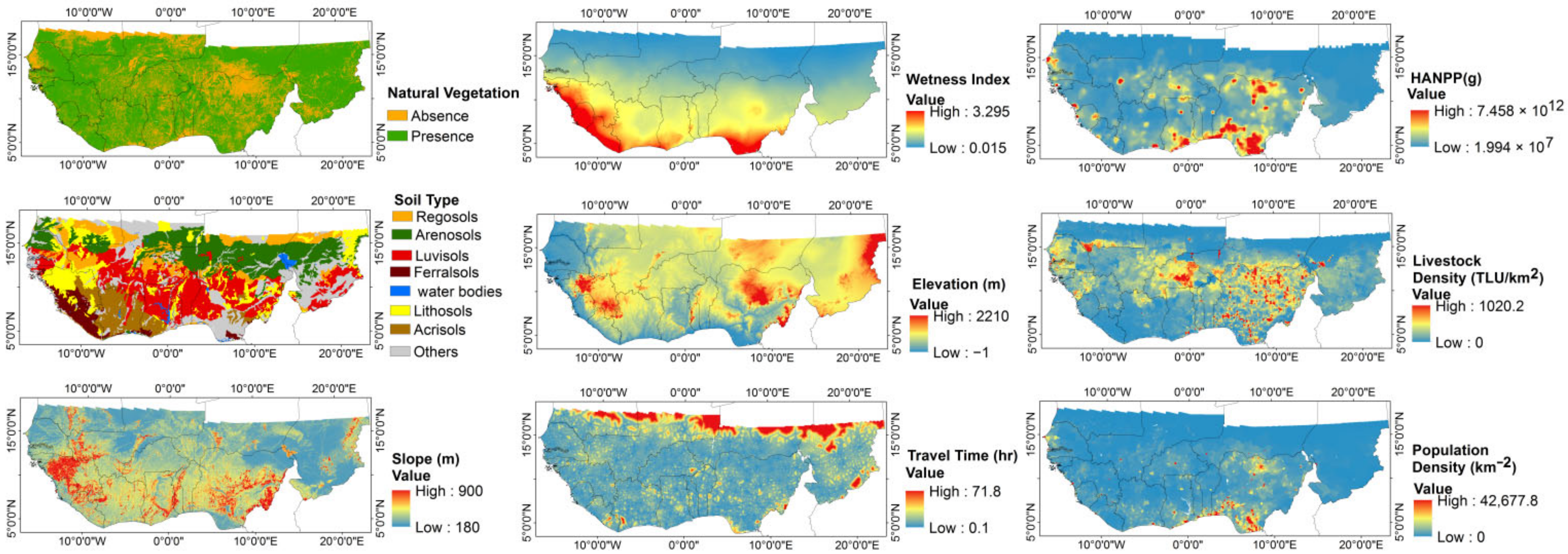
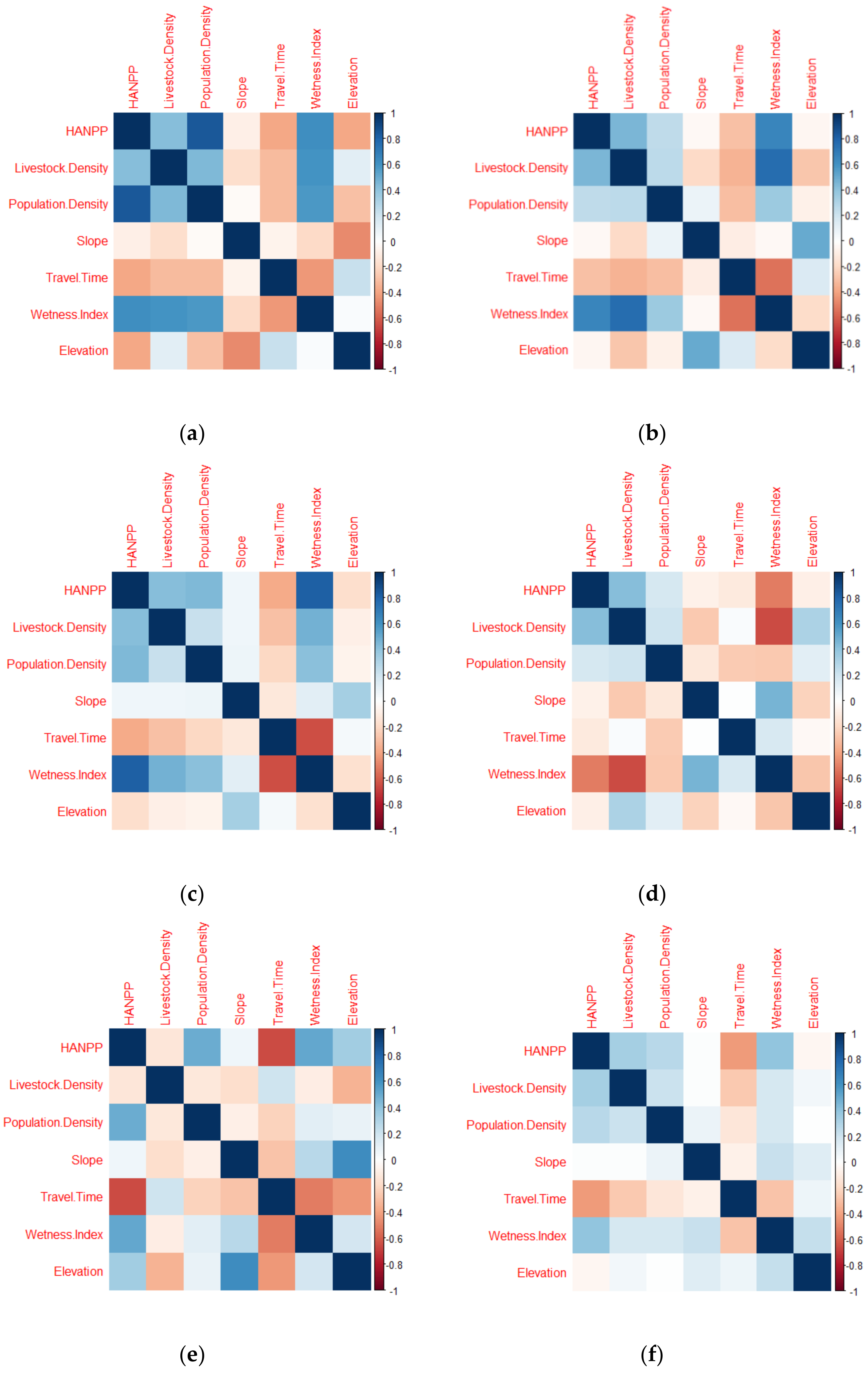
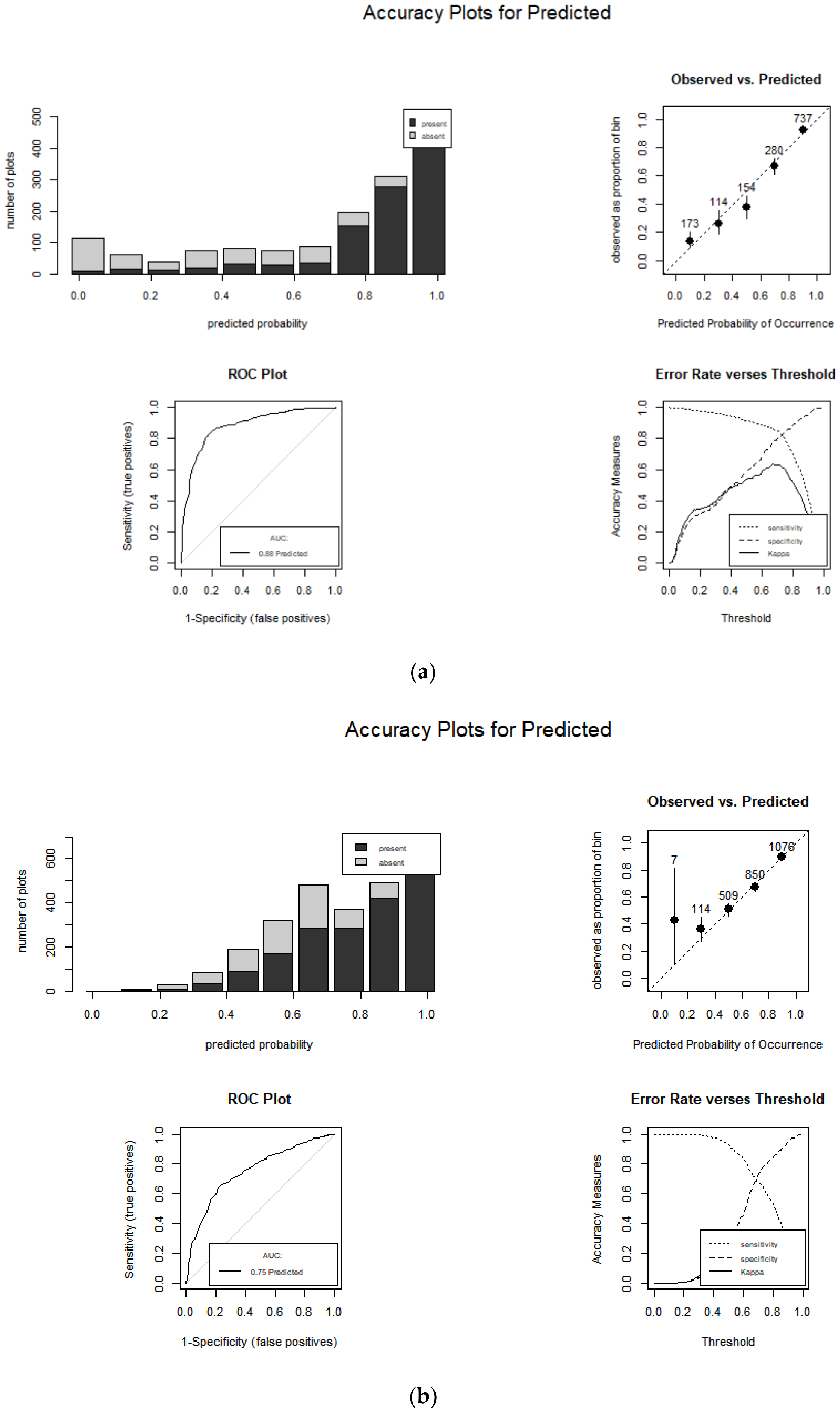
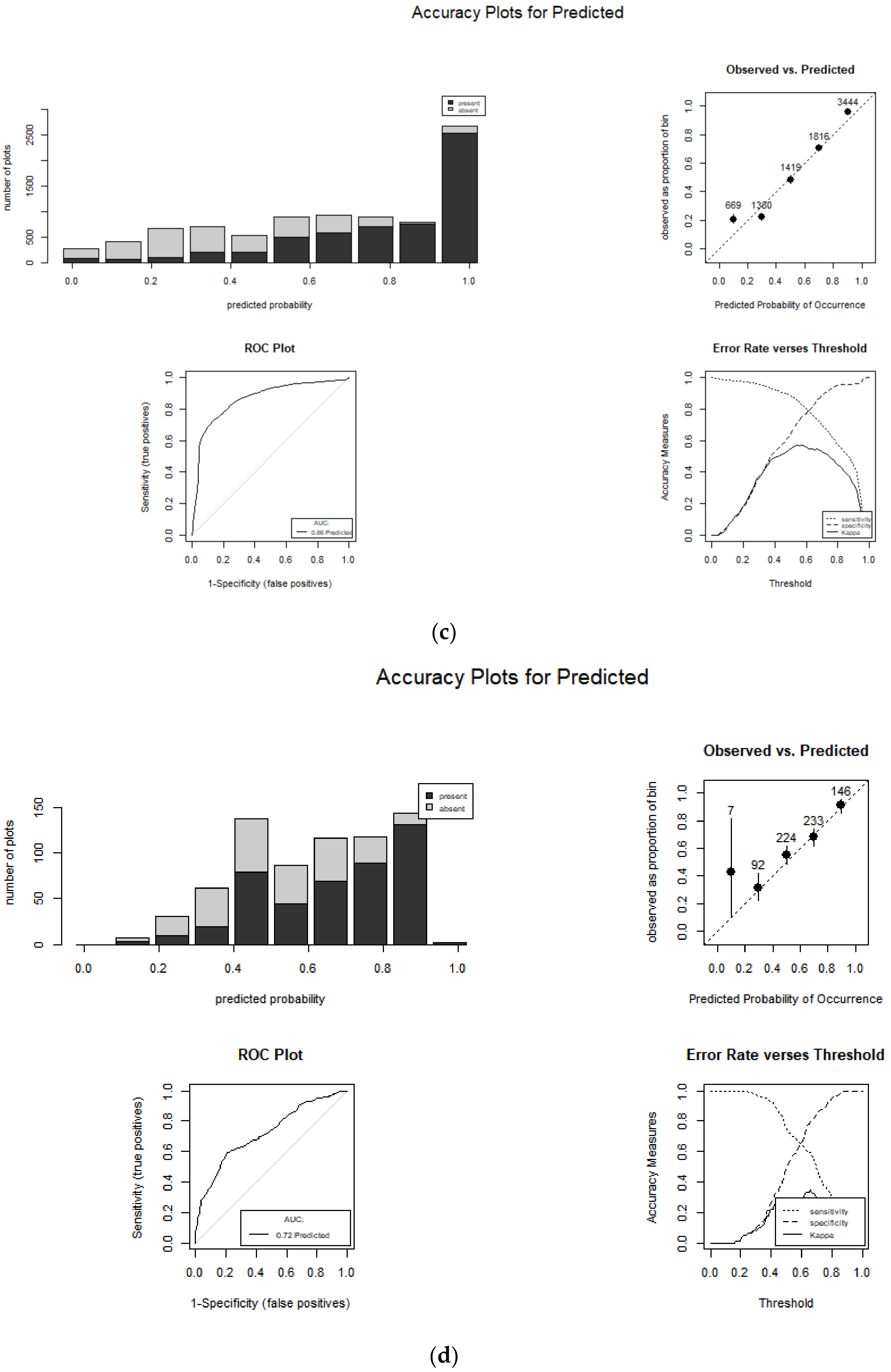

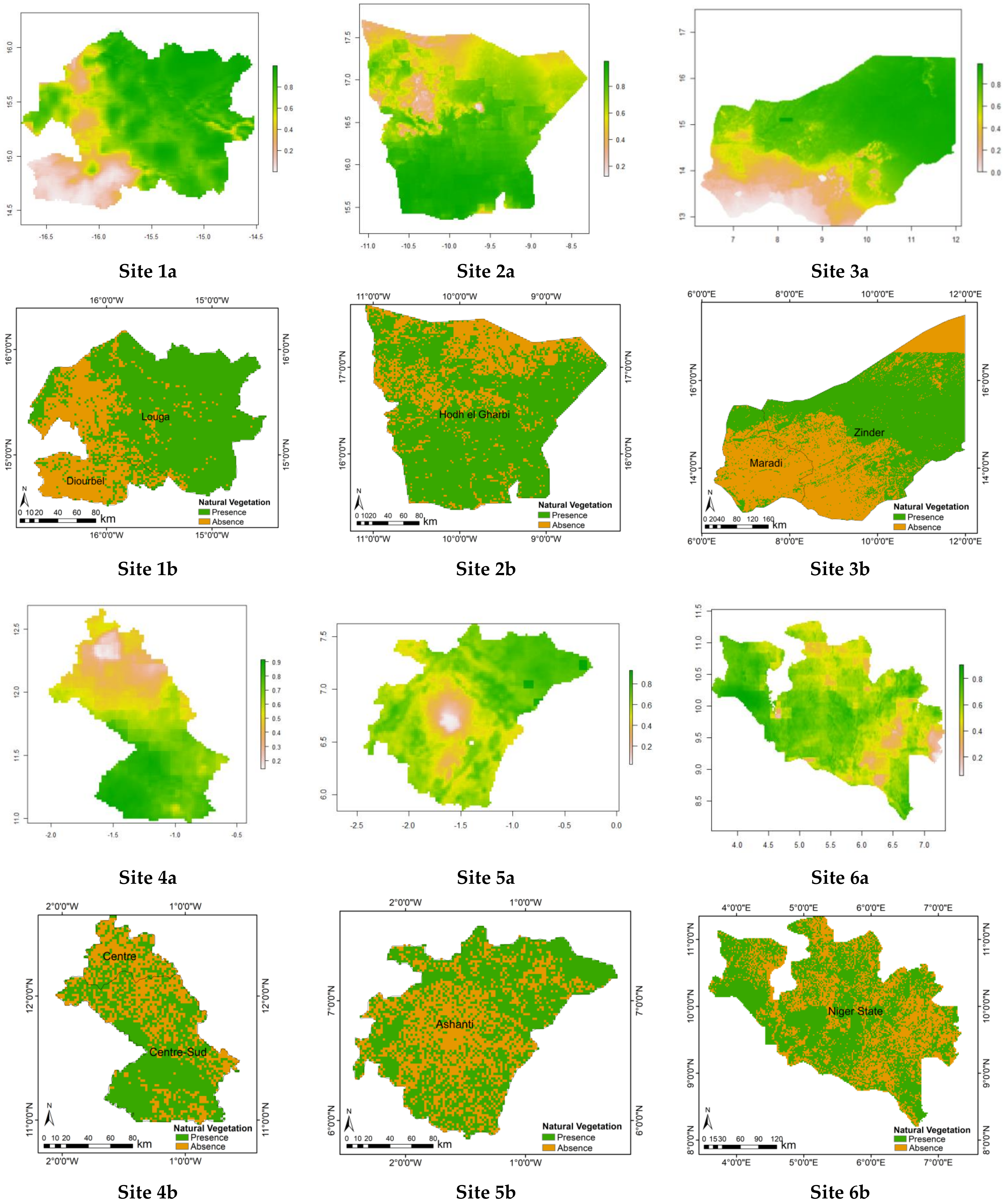

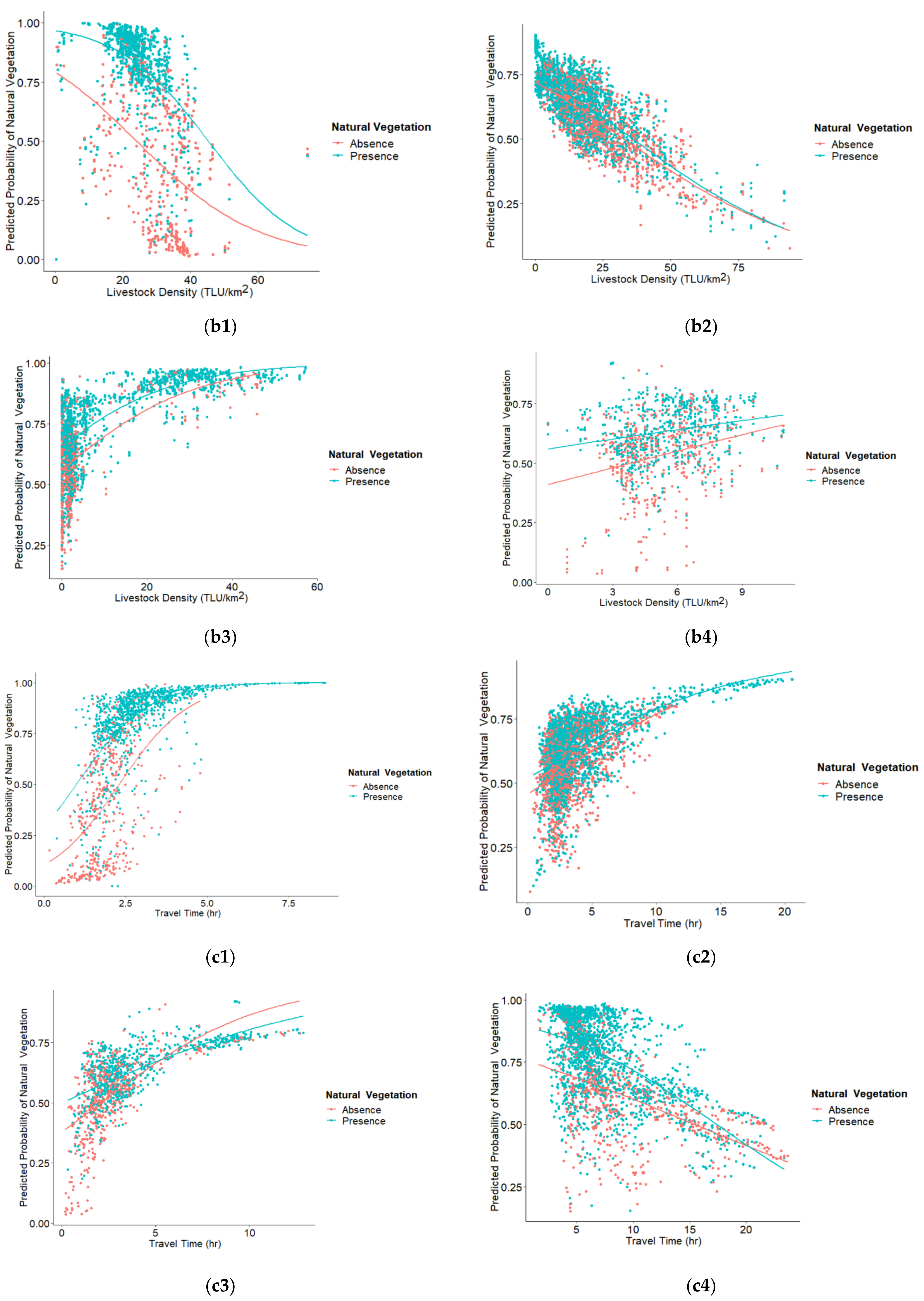
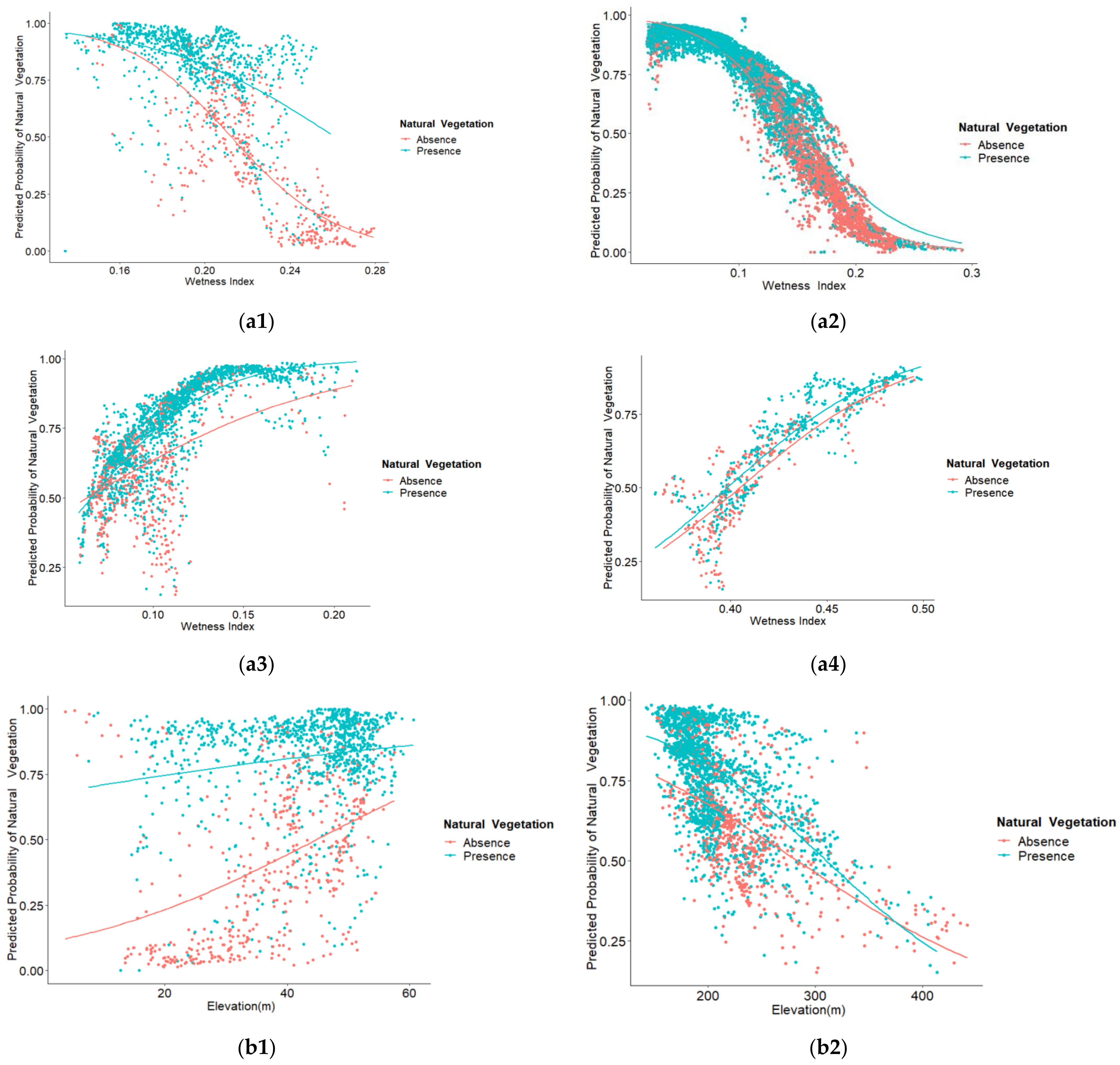
| Variable | Sources | Spatial Resolution | Temporal Coverage |
|---|---|---|---|
| LULC raster map | USGS(2000) | 2000 m | 2000 |
| Elevation | NASA-SRTM | 30 m | Static |
| Slope | USGSS | 1 km | Static |
| Soil Type | FAO GEONETWORK | 10 km | Static |
| Wetness Index | CGIAR-CSI (1950–2000) | 1 km | 1950–2000 |
| Travel Time | FAO GEONETWORK-Harvest Choice | 10 km | Benchmarked 2000 |
| Live Stock Density | FAO GEONETWORK-Harvest Choice | 5 km | Benchmarked 2000 |
| HANPP | SEDEC | 28 km | 1975–2000 |
| Population Density | SEDEC | 1 km | 2000 |
| Study Sites | Variables | Mean | SD | Median | Minimum | Maximum | Range | Skew | Kurtosis | SE |
|---|---|---|---|---|---|---|---|---|---|---|
| 1. Diourbel-Louga, Senegal | HANPP (g) | 8.94 × 1010 | 1.03 × 1011 | 4.15 × 1010 | 1.05 × 1010 | 4.89 × 1011 | 4.78 × 1011 | 1.53 | 1.25 | 1.27 × 109 |
| Number of Samples = 6557 | Livestock Density (TLU/km2) | 26.19 | 8.64 | 25.40 | 0.20 | 96.25 | 96.05 | 0.47 | 3.08 | 0.11 |
| Population Density (people km−2) | 57.73 | 79.92 | 11.58 | 2.55 | 308.24 | 305.69 | 2.14 | 3.59 | 0.99 | |
| Slope (m) | 251.71 | 37.02 | 237.91 | 203.81 | 583.57 | 379.76 | 2.47 | 9.55 | 0.46 | |
| Travel Time (hr) | 2.60 | 1.17 | 2.38 | 0.17 | 10.27 | 10.10 | 1.63 | 4.60 | 0.01 | |
| Wetness Index | 0.20 | 0.03 | 0.20 | 0.13 | 0.28 | 0.15 | 0.20 | −0.37 | 0.00 | |
| Elevation (m) | 40.96 | 11.28 | 43.86 | 2.52 | 60.64 | 58.13 | −0.85 | −0.05 | 0.14 | |
| 2. Hodh el Gharbi | HANPP (g) | 6.39 × 109 | 5.82 × 109 | 5.15 × 109 | 8.58 × 108 | 6.37 × 1010 | 6.29 × 1010 | 4.82 | 2.85 × 101 | 5.42 × 107 |
| Number of Samples = 11,498 | Livestock Density (TLU/km2) | 10.43 | 13.64 | 2.49 | 0.00 | 57.30 | 57.30 | 1.29 | 0.47 | 0.13 |
| Population Density (people km−2) | 4.55 | 6.72 | 3.97 | 0.11 | 114.77 | 114.65 | 9.49 | 127.97 | 0.06 | |
| Slope (m) | 327.46 | 119.27 | 290.00 | 205.20 | 899.99 | 694.79 | 2.17 | 5.11 | 1.11 | |
| Travel Time (hr) | 7.86 | 4.22 | 6.47 | 1.62 | 23.66 | 22.04 | 1.41 | 1.49 | 0.04 | |
| Wetness Index | 0.11 | 0.03 | 0.10 | 0.06 | 0.21 | 0.15 | 0.84 | 0.30 | 0.00 | |
| Elevation (m) | 213.22 | 44.44 | 201.50 | 140.13 | 444.44 | 304.31 | 1.68 | 3.68 | 0.41 | |
| 3. Zinder-Maradi, Niger | HANPP (g) | 4.52 × 1010 | 5.59 × 1010 | 1.41 × 1010 | 3.00 × 109 | 3.49 × 1011 | 3.46 × 1011 | 1.55 | 2.05 | 2.82 × 108 |
| Number of Samples = 39,277 | Livestock Density (TLU/km2) | 14.23 | 23.06 | 10.00 | 0.00 | 526.20 | 526.20 | 14.93 | 315.94 | 0.12 |
| Population Density (people km−2) | 25.22 | 64.95 | 9.66 | 0.22 | 2593.00 | 2592.78 | 20.87 | 593.26 | 0.33 | |
| Slope (m) | 299.47 | 80.40 | 280.15 | 200.36 | 896.25 | 695.88 | 2.70 | 10.71 | 0.41 | |
| Travel Time (hr) | 6.70 | 8.11 | 3.48 | 0.29 | 48.13 | 47.84 | 2.44 | 5.74 | 0.04 | |
| Wetness Index | 0.11 | 0.06 | 0.12 | 0.02 | 0.29 | 0.27 | 0.17 | −0.85 | 0.00 | |
| Elevation (m) | 428.74 | 43.17 | 430.33 | 304.08 | 603.33 | 299.24 | 0.02 | −0.45 | 0.22 | |
| 4. Centre-Centre Sud, Burkina Faso | HANPP (g) | 1.72 × 1011 | 1.20 × 1011 | 1.44 × 1011 | 2.38 × 1010 | 8.18 × 1011 | 7.94 × 1011 | 1.77 | 4.67 | 2.14 × 1019 |
| Number of Samples = 3155 | Livestock Density (TLU/km2) | 51.13 | 24.15 | 49.40 | 0.00 | 108.90 | 108.90 | 0.09 | −0.80 | 0.43 |
| Population Density (people km−2) | 119.08 | 312.64 | 55.93 | 6.93 | 1886.85 | 1879.91 | 4.98 | 23.99 | 5.57 | |
| Slope (m) | 343.12 | 43.10 | 335.39 | 254.52 | 734.40 | 479.89 | 2.76 | 14.67 | 0.77 | |
| Travel Time (hr) | 2.75 | 1.56 | 2.29 | 0.18 | 8.78 | 8.61 | 1.38 | 1.87 | 0.03 | |
| Wetness Index | 0.42 | 0.03 | 0.42 | 0.36 | 0.50 | 0.15 | 0.44 | −0.82 | 0.00 | |
| Elevation (m) | 293.25 | 26.19 | 295.44 | 205.57 | 356.24 | 150.67 | −0.41 | −0.08 | 0.47 | |
| 5. Ashanti Region, Ghana | HANPP (g) | 2.14 × 1011 | 1.19 × 1011 | 2.01 × 1011 | 5.26 × 1010 | 8.13 × 1011 | 7.60 × 1011 | 1.26 | 2.54 | 1.62 × 109 |
| Number of Samples = 5456 | Livestock density (TLU/km2) | 5.39 | 1.88 | 5.27 | 0.00 | 12.90 | 12.90 | 0.32 | 0.08 | 0.03 |
| Population density (people km−2) | 153.47 | 456.63 | 83.25 | 17.07 | 4849.50 | 4832.42 | 8.61 | 78.17 | 6.18 | |
| Slope (m) | 493.16 | 157.32 | 436.65 | 261.99 | 900.00 | 638.01 | 1.01 | −0.08 | 2.13 | |
| Travel time (hr) | 3.52 | 2.49 | 2.74 | 0.12 | 14.36 | 14.24 | 1.52 | 1.78 | 0.03 | |
| Wetness index | 0.84 | 0.09 | 0.84 | 0.69 | 1.06 | 0.37 | 0.18 | −1.11 | 0.00 | |
| Elevation (m) | 221.80 | 83.85 | 211.26 | 77.43 | 625.99 | 548.56 | 0.87 | 0.78 | 1.14 | |
| 6. Niger State, Nigeria | HANPP (g) | 6.25 × 1010 | 2.85 × 1010 | 6.03 × 1010 | 1.72 × 1010 | 1.70 × 1011 | 1.53 × 1011 | 7.05 × 10−1 | 4.16 × 10−1 | 2.27 × 108 |
| Number of Samples = 15,731 | Livestock density (TLU/km2) | 19.85 | 14.43 | 17.10 | 0.00 | 94.00 | 94.00 | 1.45 | 3.14 | 0.12 |
| Population density (people km−2) | 47.35 | 103.52 | 38.77 | 14.16 | 3117.93 | 3103.77 | 17.70 | 373.64 | 0.83 | |
| Slope (m) | 465.36 | 111.76 | 445.55 | 200.10 | 900.00 | 699.90 | 0.91 | 1.24 | 0.89 | |
| Travel time (hr) | 3.75 | 2.65 | 2.97 | 0.11 | 20.61 | 20.49 | 2.74 | 10.14 | 0.02 | |
| Wetness index | 0.61 | 0.05 | 0.62 | 0.49 | 0.76 | 0.27 | 0.05 | 0.41 | 0.00 | |
| Elevation (m) | 250.28 | 107.31 | 244.83 | 44.56 | 620.58 | 576.02 | 0.48 | −0.10 | 0.86 |
| Arid Region | ||||||
|---|---|---|---|---|---|---|
| Study Sites | Variables | Parameter Estimate β | Standard Error | Wald (Z Value) | Pr(>│Z│) | Significance Codes |
| 1. Diourbel-Louga, Senegal | Intercept | −1.150 | 6.200 × 10−1 | −1.845 | 6.500 × 10−2 | • |
| Number of Samples = 6557 | HANPP | −9.162 × 10−12 | 7.512 × 10−13 | −1.220 × 101 | 2.000 × 10−16 | *** |
| Training = 5099 | Travel Time | 6.626 × 10−1 | 5.126 × 10−2 | 1.293 × 10 | 2.000 × 10−16 | *** |
| Testing = 1458 | Slope | 1.057 × 10−2 | 1.545 × 10−3 | 6.840 | 7.940 × 10−12 | *** |
| Area Under the ROC/AUC | Livestock Density | −2.878 × 10−2 | 5.103 × 10−3 | −5.639 | 1.710 × 10−8 | *** |
| Climate Drivers = 0.83 | Elevation | 3.659 × 10−2 | 5.087 × 10−3 | 7.193 | 6.320× 10−13 | *** |
| Human Drivers = 0.87 | Soil Type | 1.949 × 10−2 | 5.878 × 10−3 | 3.316 | 9.130 × 10−4 | *** |
| Climate and Human = 0.88 | Wetness Index | −1.187 × 101 | 2.256 | −5.263 | 1.420 × 10−7 | *** |
| Population Density | 2.046 × 10−3 | 8.291 × 10−4 | 2.468 | 1.358 × 10−2 | * | |
| 2. Hodh el Gharbi, Mauritania | Intercept | 2.977 | 3.423 × 10−1 | 8.698 | 2.000 × 10−16 | *** |
| Number of Samples 11,408 | Livestock Density | 2.965 × 10−2 | 4.116 ×10−3 | 7.205 | 5.820 × 10−13 | *** |
| Training Samples = 8942 | Elevation | −9.042 × 10−3 | 7.009 × 10−4 | −1.290 × 101 | 2.000 × 10−16 | *** |
| Testing Samples = 2556 | Wetness Index | 2.008 × 101 | 2.216 | 9.063 | 2.000 × 10−16 | *** |
| Area Under the ROC/AUC | HANPP | −5.577 × 10−11 | 6.688 × 10−12 | −8.338 | 2.000 × 10−16 | *** |
| Climate Drivers = 0.74 | Slope | −2.113 × 10−3 | 2.530 × 10−4 | −8.353 | 2.000 × 10−16 | *** |
| Human Drivers = 0.71 | Soil Type | −5.705 × 10−2 | 8.708 × 10−3 | −6.551 | 5.700 × 10−11 | *** |
| Climate and Human = 0.75 | Travel Time | −4.374 × 10−2 | 7.004 ×10−3 | −6.245 | 4.240 × 10−10 | *** |
| Population Density | −2.104 × 10−2 | 4.141 × 10−3 | −5.081 | 3.750 × 10−7 | *** | |
| 3. Zinder-Maradi, Niger | Intercept | 6.035 | 2.276 × 10−1 | 2.651 × 10 | 2.00 × 10−16 | *** |
| Number of Samples = 39,277 | Wetness Index | −2.250 × 101 | 7.572 × 10−1 | −2.972 × 101 | 2.000 × 10−16 | *** |
| Training Samples = 30,549 | Population Density | −1.382 × 10−2 | 1.042 × 10−3 | −1.326 × 101 | 2.000 × 10−16 | *** |
| Testing Samples = 8728 | Slope | −3.063 × 10−3 | 1.923 × 10−4 | −1.593 × 101 | 2.000 × 10−16 | *** |
| Area Under the ROC/AUC | Travel Time | −3.527 × 10−2 | 3.264 × 10−3 | −1.081 × 101 | 2.000 × 10−16 | *** |
| Climate Drivers = 0.86 | HANPP | −4.768 × 10−12 | 6.011 × 10−13 | −7.932 | 2.150 × 10−15 | *** |
| Human Drivers = 0.87 | Soil Type | −2.089 × 10−2 | 4.910 × 10−3 | −4.255 | 2.090 × 10−5 | *** |
| Climate and Human = 0.88 | Livestock Density | 5.008 × 10−3 | 1.585 × 10−3 | 3.159 | 1.583 × 10−3 | ** |
| DEM | −1.498 × 10−3 | 4.078 × 10−4 | −3.674 | 2.390 × 10−4 | *** | |
| Humid Region | ||||||
| 4. Centre-Centre Sud, Burkina Faso | Intercept | −1.761 | 1.255 | −1.403 | 1.606 × 10−1 | |
| Number of Samples = 3155 | Wetness Index | 1.277 × 10 | 2.433 | 5.247 | 1.550 × 10−7 | *** |
| Training Samples = 2453 | Livestock Density | −1.290 × 10−2 | 2.555 × 10−3 | −5.050 | 4.430 × 10−7 | *** |
| Testing Samples = 702 | Population Density | −5.907 × 10−4 | 1.701 × 10−4 | −3.473 | 5.160 × 10−4 | *** |
| Area Under the ROC/AUC | HANPP | −1.546 × 10−12 | 4.601 × 10−13 | −3.359 | 7.810 × 10−4 | *** |
| Climate Drivers = 0.70 | Elevation | −4.879 × 10−3 | 1.888 × 10−3 | −2.585 | 9.751 × 10−3 | ** |
| Human Drivers = 0.71 | Slope | −2.376 × 10−3 | 1.212 × 10−3 | −1.960 | 4.995 × 10−2 | * |
| Climate and Human = 0.72 | Travel Time | 4.854 × 10−2 | 3.027 × 10−2 | 1.603 | 1.089 × 10−1 | |
| 5.Ashanti Region, Ghana | Intercept | −8.415 × 10−2 | 2.295 × 10−1 | −3.670×10−1 | 7.139 × 10−1 | |
| Number of Samples = 5456 | HANPP | −3.001 × 10−12 | 4.520 × 10−13 | −6.639 | 3.170 × 10−11 | *** |
| Training Samples = 4243 | Slope | 1.947 × 10−3 | 2.850 × 10−4 | 6.832 | 8.380 × 10−12 | *** |
| Testing Samples = 1213 | Travel Time | 7.631 × 10−2 | 1.997 × 10−2 | 3.821 | 1.330 × 10−4 | *** |
| Area Under the ROC/AUC | Elevation | −1.388 × 10−3 | 5.701 × 10−4 | −2.435 | 1.489 × 10−2 | * |
| Climate Drivers = 0.64 | Population Density | −3.783 × 10−4 | 1.574 × 10−4 | −2.403 | 1.626 × 10−2 | * |
| Human Drivers = 0.66 | Soil Type | −1.329 × 10−3 | 5.089 × 10−4 | −2.611 | 9.038 × 10−3 | ** |
| Climate and Human = 0.70 | Livestock Density | 4.529 × 10−2 | 1.893 × 10−2 | 2.393 | 1.671 × 10−2 | * |
| 6. Niger State, Nigeria | Intercept | 7.181 × 10−1 | 1.164 × 10−1 | 6.168 | 6.910 × 10−10 | *** |
| Number of Samples 15,731 | Livestock Density | −2.247 × 10−2 | 1.471 × 10−3 | −1.528 × 101 | 2.000 × 10−16 | *** |
| Training Samples = 12,235 | HANPP | −8.350 × 10−12 | 7.862 × 10−13 | −1.062 × 101 | 2.000 × 10−16 | *** |
| Testing Samples = 3496 | Slope | 1.660 × 10−3 | 1.791 × 10−4 | 9.267 | 2.000 × 10−16 | *** |
| Area Under the ROC/AUC | Travel Time | 6.759 ×1 0−2 | 9.492 × 10−3 | 7.121 | 1.070 × 10−12 | *** |
| Climate Drivers = 0.57 | Elevation | −1.173 × 10−3 | 1.819 × 10−4 | −6.449 | 1.130 × 10−10 | *** |
| Human Drivers = 0.63 | Soil Type | 8.765 × 10−4 | 2.307 × 10−4 | 3.799 | 1.450 × 10−4 | *** |
| Climate and Human = 0.65 | Population Density | −4.071 × 10−4 | 2.129 × 10−4 | −1.912 | 5.585 × 10−2 | • |
| Significance. Codes | p < 0.001 *** | p < 0.01 ** | p < 0.05 * | p < 0.1 • | 1 |
| Study Sites | Continuous Variables | VIF (Full Model) | Eigen Values |
|---|---|---|---|
| 1. Diourbel-Louga-Senegal | Elevation | 16.8 | 0.1 |
| AIC = 4255.4 | Slope | 16.1 | 0.6 |
| BIC = 4314.2 | Wetness Index | 20.6 | 0.3 |
| Log Likelihood = −2118.7 | Travel Time | 18.6 | 0.4 |
| Deviance = 4247.4 | Live Stock Density | 9.9 | 1.7 |
| Training samples = 5099.0 | HANPP | 30.4 | 3.1 |
| Kappa and Conditional Number = 23.5 | Population Density | 22.4 | 0.8 |
| 2. Hodh el Gharbi, Mauritania | Elevation | 8.7 | 0.2 |
| AIC = 8935.7 | Slope | 8.1 | 0.7 |
| BIC = 8999.6 | Wetness Index | 39.1 | 0.4 |
| Log Likelihood = −4458.9 | Travel Time | 7.8 | 0.5 |
| Deviance = 8917.7 | Live Stock Density | 28 | 1.5 |
| Training Samples = 8942.0 | HANPP | 13.5 | 2.8 |
| kappa and Conditional Number = 17.9 | Population Density | 6.6 | 0.9 |
| 3. Zinder-Maradi, Niger | Elevation | 9.4 | 0.1 |
| AIC = 27,333.9 | Slope | 7.2 | 0.7 |
| BIC = 27,408.9 | Wetness Index | 58.6 | 0.5 |
| Log Likelihood = −13,658.0 | Travel Time | 21.4 | 0.6 |
| Deviance = 27,315.9 | Live Stock Density | 40.5 | 1.3 |
| Training Samples = 30,549.0 | HANPP | 34.5 | 2.9 |
| Kappa and conditional Number = 24.4 | Population Density | 145.8 | 0.8 |
| 4.Centre-Cente-Sud, Burkina Faso | Elevation | 6.1 | 0.3 |
| AIC = 2988.6 | Slope | 7.2 | 0.8 |
| BIC = 2980.1 | Wetness Index | 15.1 | 0.4 |
| Log Likelihood = −1458.8 | Travel Time | 5.5 | 0.7 |
| Deviance = 2917.6 | Live Stock Density | 9.4 | 1.2 |
| Training Samples = 2453 | HANPP | 7.9 | 2.5 |
| Kappa and conditional Number = 10.1 | Population Density | 6.9 | 1.1 |
| 5. Ashanti Region, Ghana | Elevation | 10.6 | 0.2 |
| AIC = 5366.5 | Slope | 9.5 | 0.7 |
| BIC = 5417.3 | Wetness Index | 7.5 | 0.5 |
| Log Likelihood = −2675.2 | Travel Time | 10.9 | 0.3 |
| Deviance = 5350.5 | Live Stock Density | 5.4 | 1.4 |
| Training Samples = 4243.0 | HANPP | 14.4 | 2.8 |
| Kappa and conditional Number = 13.9 | Population Density | 21.9 | 0.9 |
| 6.Niger State, Nigeria | Elevation | 4.9 | 0.5 |
| AIC = 15,426.0 | Slope | 5.1 | 0.9 |
| BIC = 15,485.3 | Wetness Index | 6.0 | 0.6 |
| Log Likelihood = −7705.0 | Travel Time | 7.9 | 0.8 |
| Deviance = 15,409.9 | Live Stock Density | 5.5 | 1.3 |
| Training Samples = 12,235.0 | HANPP | 6.7 | 2.1 |
| Kappa and conditional Number = 4.6 | Population Density | 6.5 | 0.9 |
| Study Sites | Underlying Driving Factors | |||||||
|---|---|---|---|---|---|---|---|---|
| West Africa | HANPP | Pop. Density | L. Density | Travel Time | Slope | Elevation | Soil Type | W. Index |
| 1. Diourbel-Louga, Senegal | Negative *** | Positive * | Negative *** | Positive *** | Positive *** | Positive *** | Positive *** | Negative *** |
| 2. Hodh el Gharbi, Mauritania | Negative *** | Negative **** | Positive *** | Negative *** | Negative *** | Negative *** | Negative *** | Positive *** |
| 3. Zinder-Maradi, Niger | Negative *** | Negative**** | Positive ** | Negative *** | Negative *** | Negative *** | Negative *** | Negative *** |
| 4. Centre-Centre-Sud, Burkina Faso | Negative *** | Negative**** | Negative *** | Insignificant | Negative * | Negative ** | Insignificant | Positive *** |
| 5. Ashanti Region, Ghana | Negative *** | Negative * | Positive * | Positive *** | Positive *** | Negative * | Negative ** | Insignificant |
| 6. Niger State, Nigeria | Negative *** | Negative • | Negative *** | Positive *** | Positive *** | Negative *** | Positive *** | Insignificant |
Publisher’s Note: MDPI stays neutral with regard to jurisdictional claims in published maps and institutional affiliations. |
© 2021 by the authors. Licensee MDPI, Basel, Switzerland. This article is an open access article distributed under the terms and conditions of the Creative Commons Attribution (CC BY) license (https://creativecommons.org/licenses/by/4.0/).
Share and Cite
Asenso Barnieh, B.; Jia, L.; Menenti, M.; Jiang, M.; Zhou, J.; Zeng, Y.; Bennour, A. Modeling the Underlying Drivers of Natural Vegetation Occurrence in West Africa with Binary Logistic Regression Method. Sustainability 2021, 13, 4673. https://doi.org/10.3390/su13094673
Asenso Barnieh B, Jia L, Menenti M, Jiang M, Zhou J, Zeng Y, Bennour A. Modeling the Underlying Drivers of Natural Vegetation Occurrence in West Africa with Binary Logistic Regression Method. Sustainability. 2021; 13(9):4673. https://doi.org/10.3390/su13094673
Chicago/Turabian StyleAsenso Barnieh, Beatrice, Li Jia, Massimo Menenti, Min Jiang, Jie Zhou, Yelong Zeng, and Ali Bennour. 2021. "Modeling the Underlying Drivers of Natural Vegetation Occurrence in West Africa with Binary Logistic Regression Method" Sustainability 13, no. 9: 4673. https://doi.org/10.3390/su13094673
APA StyleAsenso Barnieh, B., Jia, L., Menenti, M., Jiang, M., Zhou, J., Zeng, Y., & Bennour, A. (2021). Modeling the Underlying Drivers of Natural Vegetation Occurrence in West Africa with Binary Logistic Regression Method. Sustainability, 13(9), 4673. https://doi.org/10.3390/su13094673








